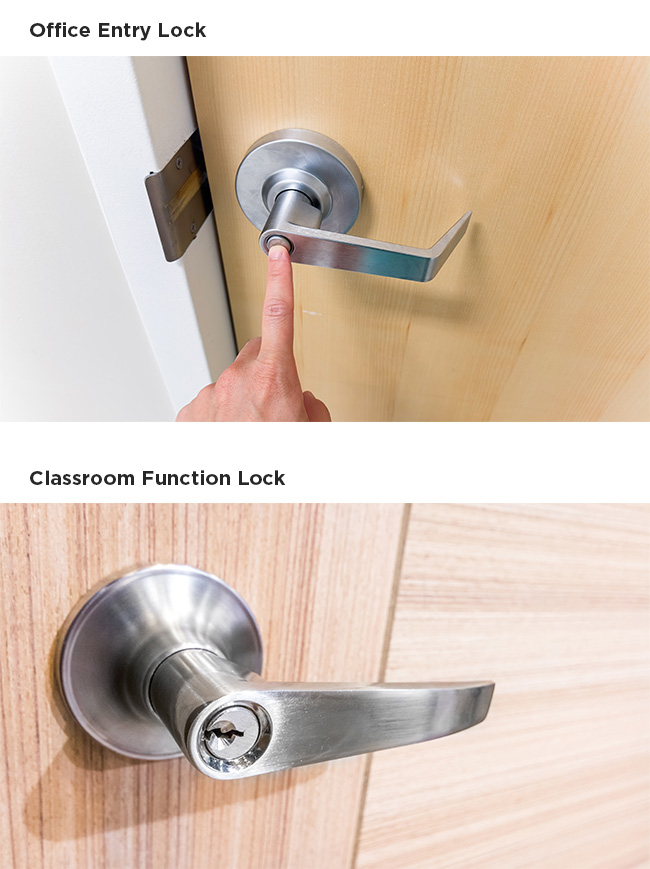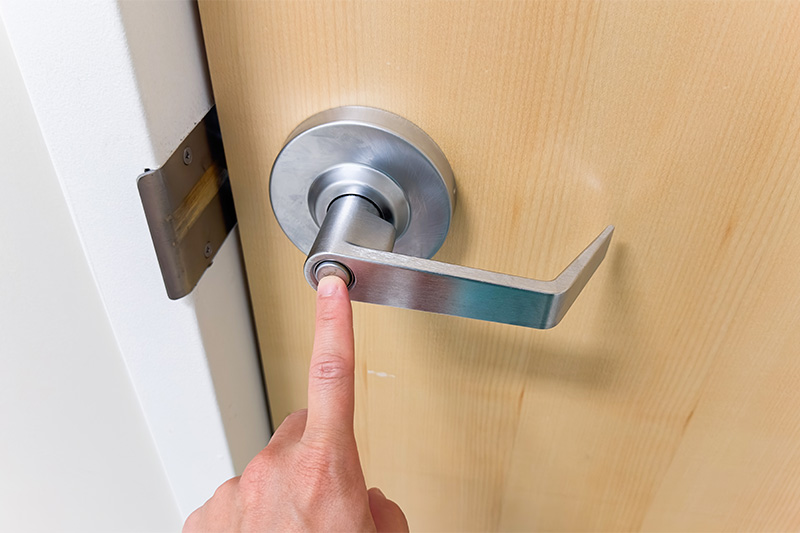Schools deploy a variety of safety protocols in an effort to protect students, staff, and visitors from a wide range of threats and hazards, both natural and human made, including active shooters or school-based mass shootings. One of the most widely used protocols to address threats within the building are lockdowns. It is estimated that as many as 95 percent of schools in the United States conduct lockdown drills at least once per year. Although there may be differences based on the protocol used, lockdown procedures typically include the steps of locking the door, turning off lights, moving out of the line of sight, remaining silent, and not responding to prompts from outside the classroom door. These actions are intended to be used for any type of threat in or immediately around a school, though they are most often discussed relative to an active shooter event.
Why is the door lock so important?
Current research has examined student and school staff perceptions of fear, safety, and preparedness following lockdown drills as well as skill retention following some form of lockdown or response training. While all aspects of the lockdown procedure are important, time and time again, scholars point to the successful locking of the door as the most important step. This intuitively makes sense: if the door is not secured, then the threat has access to the location where students, staff, and visitors may be sheltering.
While it may seem like a simple task, engaging a lock requires fine motor skills that can rapidly degrade under acute stress. Furthermore, the type of lock can also impact if someone is able to accurately engage the locking mechanism. For this reason, the type of door lock can impact how quickly someone is able to deny access to their classroom.
What are the primary types of door locks and how do they differ?
The two primary types of door locks are office entry locks and classroom function locks (also known as storeroom locks). An office entry lock can be secured from inside the room using a thumb-turn or push of a button. The office entry lock normally has keyed access on the outside of the lock that allows users to unlock the door from the hallway. Comparatively, a classroom function lock can generally only be locked and unlocked using a key from outside of the classroom (i.e., in the hallway). There are benefits and drawbacks to both types of locks.
Types of Door Locks

Classroom function locks. Classroom function locks are widely used in schools. The main benefit of the classroom function lock is that students are not able to lock themselves, teachers, or others out of the classroom either accidentally or on purpose. This is because the lock can only be activated with a key from outside of the room. However, the drawbacks include:
- Teachers and staff are required to enter the hallway to lock the door in a lockdown.
- Students are unable to lock the door in the event a teacher or staff member is not present or is otherwise incapacitated.
- Substitute teachers may not have access to the keys needed to lock the door as they are there on a temporary basis.
- Teachers may also misplace their classroom keys.
To get around some of these issues, some schools have policies in place to leave classroom function locks permanently engaged and only open doors during passing periods. While this alleviates the need for a teacher or staff member to lock the door during an emergency, the policy does create other issues. One such issue occurred during the February 14, 2018, attack at Marjory Stoneman Douglas High School in Parkland, Florida. Students and teachers on the third floor of the impacted building evacuated their classrooms due to the fire alarm sounding and then were unable to get back in once the doors shut behind them.
Office entry locks. The office entry lock requires users to push a button or turn a small knob from inside the classroom to activate the locking mechanism. This process allows anybody on the inside of the classroom to lock the door. The major drawback of this type of lock is that unruly students may lock teachers, staff, or other students out of the classroom. However, most of these locks do have keyed access from the hallway, which helps minimize this issue if the teacher or staff member is outside of the classroom with a key.
The major benefit of an office entry lock is that anybody can activate the lock from inside the classroom. This means nobody must enter the hallway to lock it with a key, students can activate the lock in the event the teacher is not present or incapacitated, and the lock doesn’t require as much fine motor skill to operate due to the simple design.
While all aspects of the lockdown procedure are important, time and time again, scholars point to the successful locking of the door as the most important step.
What does the research say?
Our Advanced Law Enforcement Rapid Response Training (ALERRT) research team conducted a simple experiment to better understand if there are differences between classroom function and office entry locks when the user is under a small amount of acute stress. To do this, we randomly assigned 95 adult-aged participants to conditions with either a classroom function or an office entry lock. The classroom was a laboratory space at the ALERRT training facility. Participants were made aware of the two conditions and procedures during the consenting process. If they were assigned a classroom function lock, participants were given a lanyard with the key to activate the lock. All participants were placed 35 feet from the door at a desk. As soon as they heard gunfire from a training gun, they rushed to the door and activated the lock. While the participant was activating the lock, a member of the research team fired the training gun one more time. To control as many factors as possible, we did not have students present, desks in the way, or anything else that could have interfered with the participant’s ability to get to the door. This was a best-case scenario because participants only had to activate the lock and shut the door without dealing with other issues (see Martaindale et al., 2023).
Participants who had to use the key to activate the classroom function lock were approximately six times more likely to fail to properly secure the door than participants with the office entry lock who had to push the button on the handle (31% failure vs 5% failure). Furthermore, participants with the classroom function lock took almost twice as long to secure the door (11.18 seconds compared to 6.59 seconds for the office entry lock). It is worth noting that participants only had a single key on their lanyard. It is likely that teachers and school staff will have multiple keys to sort through before activating the locking mechanism.
Key Findings
- Participants who had to use the key to activate the classroom function lock were approximately six times more likely to fail to properly secure the door than participants with the office entry lock who had to push the button on the handle (31% failure vs 5% failure).
- Participants with the classroom function lock took almost twice as long to secure the door (11.18 seconds compared to 6.59 seconds for the office entry lock).
Building from these findings, in time-sensitive emergencies like active shooter events, office entry locks can help ensure locks are engaged correctly and more quickly than classroom entry locks. Additionally, if schools are selecting between these two types of door locks, office entry locks that incorporate keyed access (to gain entry from the hallway) would reduce the likelihood of teachers and staff being locked out of their classrooms either accidentally or on purpose. This type of lock ensures the teacher, staff member, or students can secure the door from inside the classroom with a higher degree of success. There are, however, also other types of door locks on the market to consider, such as electronic door locks that are activated with a key fob and can be remotely locked during lockdown procedures. While there are many permutations of different types of door locks, this simple experiment shows the value in being able to secure a lock from the interior of the room. Additionally, there are many devices on the market to help secure the door in addition to door locks. While each of these should be considered, we are unaware of any experiments testing participants’ ability to correctly deploy them during a lockdown. Future research should continue this line of inquiry and assess additional styles of door locks and how prevalent each type of door lock is in US schools as this is currently unknown. Furthermore, future research efforts should include the factors that were controlled in this initial study (e.g., presence of students, additional keys on the lanyard). These future studies can provide policymakers with additional data to inform their decisions regarding door locks. Without a doubt, there would be considerable costs associated with retroactively changing every door lock in a school that currently uses classroom function locks. Empirical findings from ongoing research efforts can help guide policymakers when crafting policy or legislation regarding school safety initiatives such as incorporating office entry locks throughout schools. Lastly, school administrators should consult with their local law enforcement, fire marshalls, and all relevant building codes for additional guidance regarding the type of door lock that is permissible in their schools.
CORRECTION: The images of door handles have been updated to show door handles that are ADA compliant. The piece was also updated with language recommending school administrators consult with other stakeholders regarding permissible door locks.
ABOUT THE AUTHOR
Hunter Martaindale is the director of research at the Advanced Law Enforcement Rapid Response Training (ALERRT) Center at Texas State University. He is also an affiliate scholar of the Regional Gun Violence Research Consortium.

